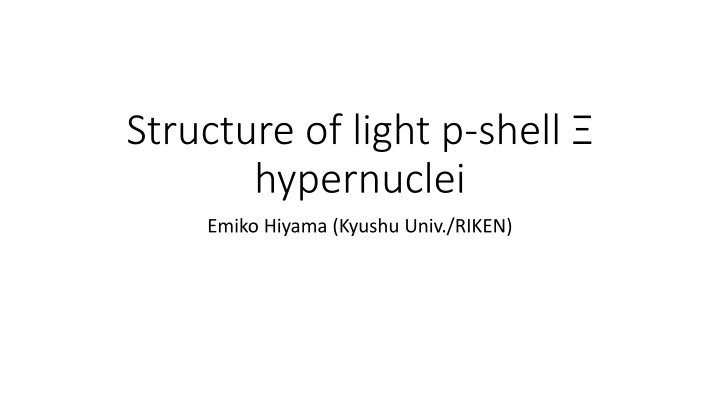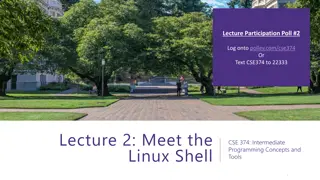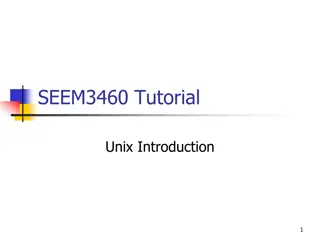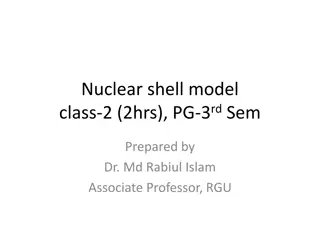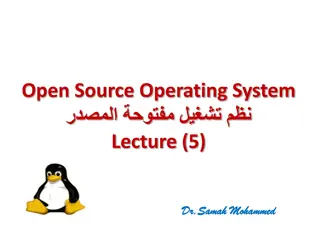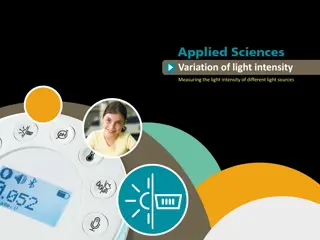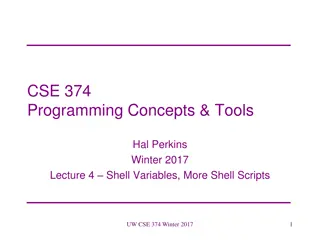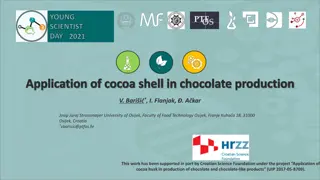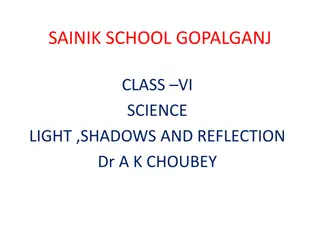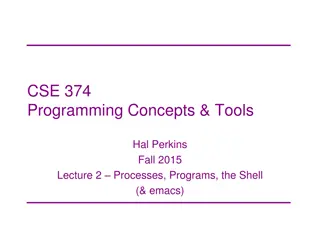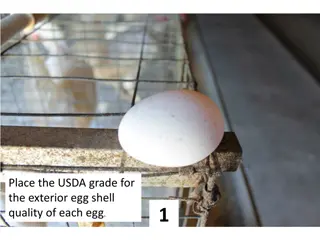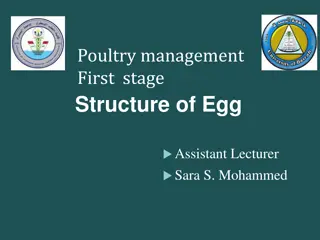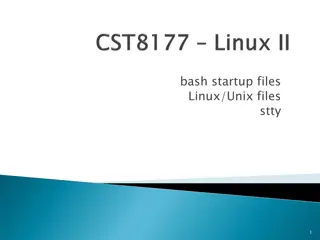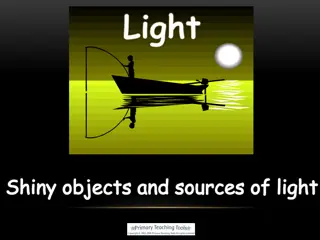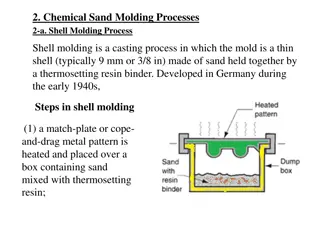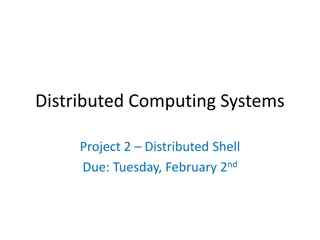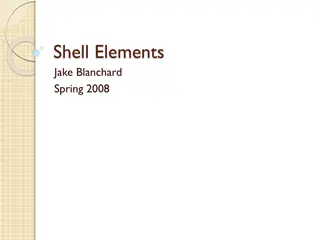Insights into Light P-Shell Hypernuclei Research
Investigating the structure of light p-shell hypernuclei and baryon-baryon interactions, addressing the challenges in data collection and analysis, and exploring energy spectra in hypernuclear physics studies.
Download Presentation

Please find below an Image/Link to download the presentation.
The content on the website is provided AS IS for your information and personal use only. It may not be sold, licensed, or shared on other websites without obtaining consent from the author.If you encounter any issues during the download, it is possible that the publisher has removed the file from their server.
You are allowed to download the files provided on this website for personal or commercial use, subject to the condition that they are used lawfully. All files are the property of their respective owners.
The content on the website is provided AS IS for your information and personal use only. It may not be sold, licensed, or shared on other websites without obtaining consent from the author.
E N D
Presentation Transcript
Structure of light p-shell hypernuclei Emiko Hiyama (Kyushu Univ./RIKEN)
The major goal of hypernuclear physics 1) To understand baryon-baryon interactions Fundamental and important for the study of nuclear physics To understand the baryon-baryon interaction, two- body scattering experiment is most useful. Total number of Nucleon (N) -Nucleon (N) data: 4, 000 YN and YY potential models so far proposed (ex. Nijmegen, Julich, Kyoto-Niigata) have large ambiguity. Total number of differential cross section Hyperon (Y) -Nucleon (N) data: 40 NO YY scattering data
Therefore, as a substitute for the 2-body limited YN and non-existent YY scattering data, the systematic investigation of the structure of light hypernuclei is essential. Next step, it is important to extract information on N interaction.
14N-- 0 MeV -4.38 0.25 -1.10 0.25 MeV - 14N Kiso event Furthermore, we observed bound hypernucleus, for the first time in the world. Now, we understood that N interaction should be attractive. Also, it is important to interpret spin-parity to comparing theory and experimental data.
- core nucleus For the study of N interaction, it is important to study the structure of hypernuclei.
Physical Review C 94, 064319 (2016) Using RMF theory, we interpret that Kiso event is observation of 14N(g.s) + (0p) state. Weak point: RMF theory focus on the only ground state of 14N, not the excited state of 14N. It is planning to take into account of the excited state of 14N for further analysis of Kiso event using + + +d+ 5-body cluster model.
Spectroscopic study of -Hypernucleus, 12Be, via the 12C(K-,K+) Reaction by Nagae and his collaborators - K+ K- - p 11B 11B 12C hypernucleus This experiment has been done, also. The observed data will be reported by Prof. Nagae (next session). Question: what kind of energy spectra do we have in this hypernucleus, theoretically?
12Be - - For this purpose, it is requested to calculate energy spectra of . Total isospin of 11B : Isospin of : Total isospin of 11B+ : 1 and 0 K+ K- - p Tzof 11B: -1/2 -: -1/2 Total tzof 11B+ -1 Then, by the experiment, T=1 state of 11B+ - can be produced. 11B 11B 12C hypernucleus But, first we want to know what are energy spectra in this system?
For the calculation of 12Be - - Prof. Motoba calculated energy spectra within the framework of shell model using Nijmegen potential (ESC04d, ESC08a). T. Motoba and S. Sugimoto, NPA 835 (2010) 223 12Be - - Now, it is important to sudy energy spectra of 12Be Within the framework of + +t+ 4-body model. - - t - -
12Be - - V : reproduce scattering phase shift V t: reproduce low-lying properties of t system t - - rules out the Pauli-forbidden states from the 5-body wave unction. The Pauli-forbidden states (f ) are the 0S, 1S and 0D states of the relative motion, and the 0S, 1S, 0P and 0D states of the t relative motion. This method for the Pauli principle (Orthogonality-Condition Model) is often employed in the study of light nuclei using microscopic cluster models. The energy spectra of 11B are reproduced with the data. V YNG ESC08c potential
Energy spectra 11B+ 11B+ -1.75 1- -1.27 -1.61 1- 2- -2.116 2- 0- -3.30 2- -4.06 -4.45 0- -4.99 =0.38 1- 1- -5.44 -6.02 2- -7.35 =0.58 2- T=1 T=1 are lower than T=0. Only T=1 spectra by the reaction by (K+,K-) are produced. In this way, we have many energy spectra by (K+.K-) reaction, It is interesting to see what kind of states we produce by the reaction. The data will be reported by Prof. Nagae. The calculation using cluster wavefunction are next plan. -8.69 MeV =0.65 1- T=0
VN = V0 + V V ( )( ) V 15 C In this way, we are finding to have bound states in these systems and then we shall get information that V Nitself is attractive. d All of the terms contribute to binding energy of 12Be and 15 C ( 11B and 14N is not spin-, isospin- saturated). 12Be - - - t - - Next, we want to know desirable strength of V0, the spin-,isospin-independent term.
VN = V0 + V V ( )( ) V In order to obtain useful information about V0, the following systems are suited, because the ( ), ( ) and ( ) ( ) terms of V Nvanish by folding them into the -cluster wave function that are spin-, isospin-satulated. - - problem : there is NO target to produce them by the (K-, K+) experiment . Because,
To produce -and -systems by (K-, K+) reaction, K+ target K- - These systems are unbound. p 5H 5Li - Then, we cannot use them as targets. K+ K- - p 9B 9Li -
As the second best candidates to extract information about the spin-, isospin-independent term V0, we propose to perform K+ K- - n p n n n (T=3/2) 7H - 7Li (T=1/2) Why they are suited for investigating V0? K+ K - - n p n 10Li (T=1) - 10B (T=0)
(more realistic illustration) Core nucleus 6He is known to be halo nucleus. Then, valence neutrons are located far away from particle. n n - Valence neutrons are located in p-orbit, whereas particle is located in 0s-orbit. - n (T=3/2) 7H - Then, distance between and n n is much larger than the interaction range of and n. - Then, potential, in which only V0term works, plays a dominant role in the binding energies of these system. 10Li (T=1) -
Before the experiments will be done, we should predict whether these hypernuclei will be observed as bound states or not. - - n n Namely, we calculate the binding energies of these hypernuclei. (T=3/2) 7H - - n 10Li (T=1) -
N interaction Only one experimental information about N interaction Y. Yamamoto, Gensikaku kenkyu 39, 23 (1996), T. Fukuda et al. Phys. Rev. C58, 1306, (1998); P.Khaustov et al., Phys. Rev. C61, 054603 (2000). Well-depth of the potential between and 11B: -14 MeV Among all of the Nijmegen model, ESC04 (Nijmegen soft core) and ND (Nijmegen Model D) reproduce the experimental value. Other N interaction are repulsive or weak attractive. We employ ESC04 and ND. The properties of ESC04 and ND are quite different from each other.
Property of the spin- and isospin-components of ESC04 and ND V(T,S) ESC04 ND T=0, S=1 strongly attractive (a bound state) T=0, S=0 weakly repulsive weakly attractive T=1, S=1 weakly attractive T=1, S=0 weakly repulsive Although the spin- and isospin-components of these two models are very different between them (due to the different meson contributions), we find that the spin- and isospin-averaged property, V0= [ V(0,0) + 3V(0,1) + 3V(1,0) + 9V(1,1) ] / 16, namely, strength of the V0- term is similar to each other.
E. Hiyama et al., 4-body calculation of 7H - PRC78 (2008) 054316 ESC04 MeV ND + n + n + - 1.71 MeV + n + n + - 0.96 6He + - 0.75 ( -) + n + n 0.39 0.0 0.0 6He + - ( -) + n + n 1/2+ -1.35 1/2+ =0.27MeV -1.56 =2.64MeV 7H - 7H - - n Similar binding energies using ND and ESC04. n In experiments, we can expect a bound state. However, decay width is dependent on on employed N potential
E. Hiyama et al., 4-body calculation of 10Li - PRC78 (2008) 054316 ESC04d ND MeV + + n + - 5.17 MeV + + n + - 9Be + - 3.60 2.86 9Be + - ( -) + n 1.32 ( -) + n 0.0 0.0 2- 2- -2.96 -3.18 =0.75MeV =5.87MeV 10Li - - 10Li - Similar binding energies using ND and ESC04d. Independent on employed N potential n - In experiments, we can expect a bound state. But, decay width is dependent on employed N interaction.
In this way, the binding energies of hypernuclei with A=7 and 10 are dominated by potential, namely, spin-, and iso-spin independent N interaction 0 . Then, to get information about this part, we propose to perform the (K-,K+) experiment by using 7Li and 10B targets at J-PARC after the experiment with 12C target. Also next, it is interesting to know which partial contribution makes attractive for V N ?
N interaction: T=0, S=0 N T=0, S=1 T=1, S=0 T=1, S=1 We want to know which partial wave is attractive or repulsive. The suited systems to study are s-shell hypernuclei such as NN and NNN systems. N N N N N
N N N N N I show my new results of these light systems. NN interaction: AV8 potential N interaction : Nijimegen extended soft core potential (ESC08c) Realistic potential (only N channel) N interaction by HAL collaboration (Lattice QCD calculation) The potential was made by K. Sasaki and Miyamoto.
HAL potential V N=V0(r)+( N)Vs(r)+( N)Vt(r)+ N)( N)Vts(r) All terms are central parts only. V0(r) In HAL potential , the statistical errors are NOT included.
(N)Vs(r) ( N)Vt(r)
Property of the spin- and isospin-components of ESC08 and HAL V(T,S) ESC08c HAL T=0, S=1 strongly attractive Weakly attractive weakly repulsive T=0, S=0 Strongly attractive T=1, S=1 strong attractive Weakly attractive weakly repulsive T=1, S=0 Weakly repulsive Although the spin- and isospin-components of these two models are very different between them. It is interesting to see the difference in the energy spectra in s-shell hypernuclei.
T=1/2, J=1/2+and J=3/2+ N N ESC08c 0 MeV d+ d+ 0 MeV -2.07 MeV J=1/2+ -2.57 MeV J=3/2+ I used the different version of ESC08c (realistic force). However, I also have two bound states in three-body system.
T=1/2, J=1/2+and J=3/2+ N N HAL potential 0 MeV d+ d+ 0 MeV No bound state J=1/2+ J=3/2+
N N N T=1 state 3N+ 0 MeV 0 MeV 3N+ No bound state -2.25MeV 0+ HAL potential ESC08c
N N N In HAL potential , the statistical errors are NOT included. T=0 state 3N+ 0 MeV 0 MeV 3N+ 1+ 0.01 MeV 0.3 MeV No bound state Preliminary result HAL potential ESC08c
Summary Motivated by experiment of 12 Be, I calculated energy spectra of This hypernclei using ESC08c potential. We found there are many bound states and the ground state should be T=0 when we use ESC08c. In the future, it is planned to calculate reaction cross section using cluster model to compare with the data by Prof. Nagae. 12Be - - t - -
To extract information on V0part, I would suggest to perform search experiment of 7 H and 10 Li using 7Li and 10B target in the future. - n - n n (T=3/2) 7H - 10 Li
To investigate spin- isospin dependence on NN and NNN system, we calculated these systems using two types N interactions, ESC08c and HAL potential. The energies of these systems are strongly dependent on the N potential employed. To investigate this fact, I suggest to produce these hypernuclei using 3He and 4He target by (K+,K-) reaction. N N N N N
